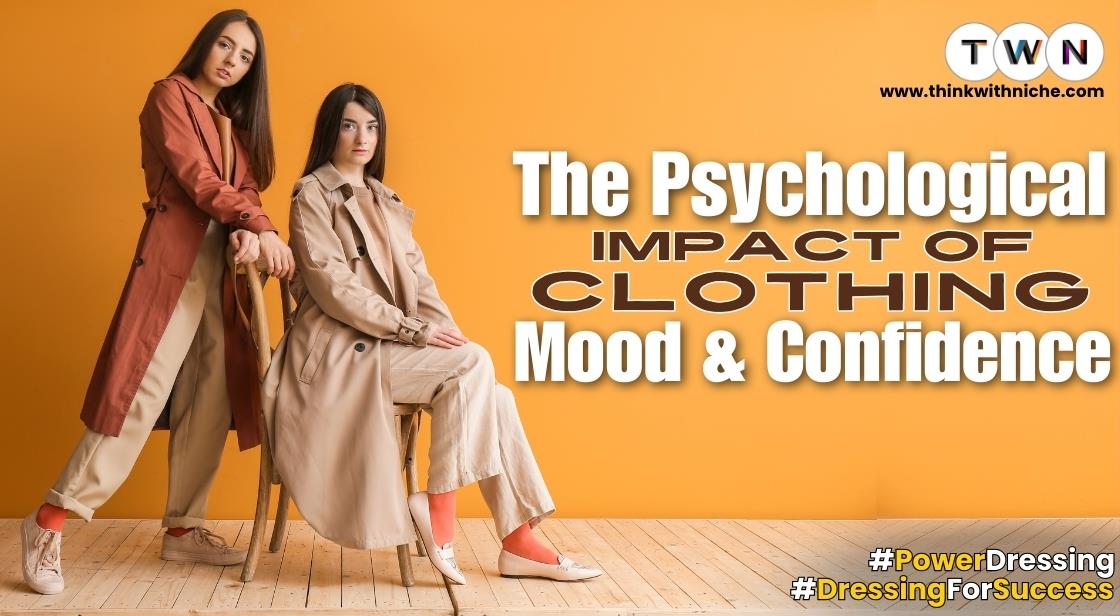The Psychological Impact of Clothing: Mood and Confidence

Blog Post
Clothing is more than just fabric draped over our bodies; it serves as a powerful form of self-expression and can significantly influence our mood and confidence levels. From the colors we choose to the styles we wear, our clothing choices can shape our psychological well-being and how we perceive ourselves in the world.
The relationship between clothing, mood, and confidence is deeply intertwined with human psychology. Research has shown that what we wear can directly impact our emotions, with certain colors and fabrics evoking specific feelings and moods.
For example, wearing bright colors like yellow or red can uplift our spirits and instill a sense of energy and positivity, while soft, comfortable fabrics may promote feelings of relaxation and comfort.
Moreover, clothing plays a crucial role in shaping our confidence levels.The idea behind "enclothed cognition" is that our clothing may affect our behavior and cognitive processes, which can alter how confident and self-assured we feel about ourselves. When we dress in attire that makes us feel powerful and put-together, we are more likely to exude confidence and assertiveness in our interactions with others.
Understanding the psychological impact of clothing is essential for harnessing its transformative power in our daily lives. By making conscious wardrobe choices that align with our desired mood and confidence levels, we can enhance our overall well-being and navigate the world with a greater sense of empowerment and self-assurance.
In this article, we will delve deeper into the intricate ways in which clothing influences our mood and confidence, and explore strategies for leveraging this knowledge to cultivate a positive self-image and enhance psychological resilience.
#DressingForSuccess #PowerDressing
How Clothing Affects Mood and Confidence: Dressing for Success
Clothing is far more than mere fabric draped over our bodies; it serves as a powerful tool influencing our emotions and self-perception. The psychological impact of clothing cannot be understated, as it has a profound effect on our mood and confidence levels. Whether we realize it or not, the clothes we choose to wear can significantly shape how we feel and how others perceive us.
The Role of Clothing in Mood Enhancement:
Our clothing choices can act as a form of self-expression, allowing us to convey our emotions and personality to the world. The colors, patterns, and styles we select can evoke specific feelings and moods within ourselves and those around us. For example, wearing bright and vibrant colors may uplift our spirits and boost our confidence, while opting for soft and muted tones can create a sense of calmness and tranquility.
Boosting Confidence Through Clothes:
Clothing plays a crucial role in shaping our self-perception and confidence levels. "Enclothed cognition" is a phenomena that claims our clothing can affect our behavior and cognitive functions.
When we dress in attire that makes us feel confident and empowered, we are more likely to exude self-assurance and assertiveness in our interactions with others. Additionally, dressing in a manner consistent with our goals and aspirations can help align our external appearance with our internal sense of identity, further bolstering our confidence.
Understanding the Importance for Personal and Professional Success:
Recognizing the relationship between clothing, mood, and confidence is essential for achieving personal and professional success. In both realms of life, our appearance can significantly impact how we are perceived by others and, consequently, our ability to achieve our goals.
By understanding how to leverage clothing to enhance our mood and confidence, we can present ourselves in a manner that commands respect, fosters positive relationships, and ultimately paves the way for success.
The Psychological Impact of Clothing:
Clothing is far more than mere fabric; it serves as a powerful tool for self-expression, influencing our mood and confidence in profound ways. At the heart of this relationship lie several psychological principles that shed light on why and how clothing affects us the way it does. The phenomenon of "enclothed cognition" suggests that the symbolic meaning of clothing can trigger mental processes that affect the wearer's behaviors and attitudes.
For example, wearing professional attire can enhance feelings of competence and authority. Additionally, color psychology reveals that different hues can evoke specific emotions, with vibrant colors uplifting our spirits and muted tones promoting calmness. Understanding these principles allows us to harness the transformative power of clothing to enhance our mood and confidence.
Clothing as a form of Self-Expression:
One of the primary ways in which clothing impacts our mood and confidence is through self-expression. Our clothing choices often reflect aspects of our personality, interests, and values, allowing us to convey who we are to the world.
Whether we opt for bold patterns, subdued hues, or quirky accessories, each choice sends a message about our identity and influences how we feel about ourselves. By aligning our clothing with our inner selves, we can experience a sense of authenticity and empowerment, boosting our mood and confidence in the process.
Social Identity:
Clothing also plays a pivotal role in shaping our social identity, or how we perceive ourselves in relation to others. The clothes we wear can signal membership in specific social groups, such as subcultures, professions, or socioeconomic classes, thereby influencing our sense of belonging and acceptance.
For example, wearing a uniform can instill a sense of pride and camaraderie among group members, while donning attire associated with a particular hobby or interest can foster connections with like-minded individuals. Our clothing choices not only reflect our social identity but can also shape it, impacting our mood and confidence as we navigate social interactions and relationships.
Cognitive Dissonance:
Furthermore, clothing can trigger cognitive dissonance—a state of psychological discomfort that arises when our beliefs or attitudes are at odds with our behavior. This phenomenon occurs when we wear clothing that conflicts with our self-perception or societal expectations, leading to feelings of unease or insecurity.
For example, Dressing casually for a formal event may evoke feelings of self-consciousness and doubt, as it contradicts the norms and expectations associated with the occasion. By understanding the role of cognitive dissonance in our clothing choices, we can make more conscious decisions that align with our self-concept, promoting harmony and confidence in our appearance.
Also Read: Top Fashion Brands: The Best Clothing Brands in the World
Mood Enhancement through Clothing:
Clothing serves as more than just a practical covering for our bodies; it's a powerful tool for influencing our emotions and mood. Different types of clothing have the ability to evoke specific emotions and moods in both the wearer and those around them.
The Role of Color:
Color psychology plays a significant role in how clothing impacts our mood. Bright, vibrant colors such as yellow and orange are often associated with feelings of happiness and energy, while calming colors like blue and green can evoke a sense of tranquility and relaxation.
The choice of color in clothing can influence our emotional state, with individuals often gravitating towards certain colors based on how they want to feel or express themselves.
The Influence of Texture:
Texture also plays a crucial role in influencing our emotional state through clothing. Soft, comfortable fabrics like cotton and cashmere can create feelings of warmth, security, and comfort, promoting a sense of relaxation and ease.
In contrast, rough or scratchy textures may evoke feelings of discomfort or agitation, negatively impacting mood. The tactile experience of clothing can significantly contribute to our overall emotional well-being, with certain textures eliciting specific emotional responses.
Styling and Mood:
Beyond color and texture, the style of clothing can also influence our emotional state. Wearing clothing that aligns with our personal style preferences and identity can boost confidence and self-esteem, leading to a more positive mood. Additionally, the fit and silhouette of clothing can impact how we perceive ourselves and how others perceive us, further influencing our emotional state.
For example, wearing well-fitted, tailored clothing may promote feelings of professionalism and competence, enhancing mood and confidence in professional settings.
Building Confidence with Clothing:
Our confidence and self-perception can be significantly impacted by the clothes we wear. When we carefully select what to wear, we are not just choosing fabrics and styles; we are curating our outward appearance to reflect our inner selves. This process of self-expression through clothing can significantly influence how we perceive ourselves and how others perceive us.
The Phenomenon of "Enclothed Cognition":
The term "enclothed cognition" describes how clothes systematically affects a wearer's psychological functions. It suggests that the symbolic meaning of clothing can trigger mental processes that affect the wearer's behaviors and attitudes.
For example, wearing clothing associated with competence and authority, such as a tailored suit or professional attire, can enhance feelings of confidence and competence. Conversely, wearing clothing associated with relaxation and comfort, such as casual loungewear, may induce a more relaxed state of mind.
Impact on Confidence Levels:
The phenomenon of enclothed cognition highlights how clothing can act as a form of non-verbal communication, signaling to ourselves and others our perceived capabilities and identities. When we dress in a manner that aligns with our desired self-image or the roles we wish to embody, it can lead to a boost in confidence. This is because we subconsciously internalize the qualities associated with the clothing we wear, adopting the mindset and behaviors that correspond with those qualities.
Confidence-Boosting Clothing Choices:
Certain types of clothing are commonly associated with confidence and empowerment. For example, wearing well-fitted garments that flatter our body shape can enhance feelings of self-assurance. Additionally, choosing clothing in colors that make us feel empowered, such as bold reds or rich blues, can further boost our confidence levels. It's not just about the physical appearance of the clothing but also the psychological associations we have with them that contribute to our confidence.
Dressing for Success:
By incorporating these practical tips and embracing the principles of power dressing, you can harness the transformative power of clothing to boost your mood, confidence, and professional success. Remember, confidence starts with how you feel, and the right outfit can be the perfect catalyst for success in any situation.
Practical Tips for Boosting Mood and Confidence through Clothing:
Clothing has a remarkable ability to influence our mood and confidence, and understanding how to leverage this power can have a significant impact on various aspects of our lives. Here are some practical tips on how to use clothing to boost mood and confidence in different situations:
-
Choose Clothes that Reflect Your Personality: Opt for outfits that resonate with your personal style and preferences. When you feel authentic and comfortable in what you're wearing, it can positively affect your mood and confidence, allowing your true self to shine through.
-
Embrace Colors Wisely: Colors can evoke specific emotions and moods, so choose hues that make you feel good. Vibrant colors like red or yellow can energize and uplift your mood, while softer tones like blue or green can promote a sense of calmness and serenity.
-
Pay Attention to Fit and Silhouette: Well-fitted clothing not only enhances your physical appearance but also boosts your confidence. Choose pieces that flatter your body shape and accentuate your best features, whether it's a tailored blazer, a fitted dress, or perfectly tailored trousers.
-
Dress for the Occasion: Consider the context and dress accordingly for different situations. Whether it's a job interview, a social event, or a casual outing, dressing appropriately can help you feel more confident and prepared to tackle whatever comes your way.
The Impact of Power Dressing on Career Achievement:
Power dressing is a concept that emphasizes wearing clothing that exudes confidence, authority, and competence, particularly in professional settings. The way you dress can significantly impact how others perceive you and can influence your own mindset and behavior. Here's how you can leverage the power of dressing for success in your career:
-
Invest in Quality Wardrobe Staples: Build a wardrobe of high-quality, timeless pieces that project professionalism and sophistication. Invest in well-tailored suits, classic blazers, crisp shirts, and polished accessories that make you feel empowered and ready to conquer the boardroom.
-
Pay Attention to Details: It's the little details that can make a big difference in how you're perceived. Ensure your clothes are clean, well-pressed, and properly accessorized. Pay attention to grooming and personal hygiene to complete your polished look.
-
Know Your Industry's Dress Code: Understand the dress code expectations in your industry and company culture, and dress accordingly. While some industries may require traditional business attire, others may embrace a more casual or creative dress code. Adapt your wardrobe choices to align with professional norms while still allowing your personal style to shine through.
-
Use Clothing to Project Confidence: Choose clothing that makes you feel powerful and confident. Whether it's a sharp suit, a tailored dress, or statement accessories, wearing outfits that command attention can boost your self-assurance and leave a lasting impression on others.
Also Read: The Hottest Trends Shaping the Fashion Industry Today
Case Studies and Examples:
Case Study: Emily's Bold Fashion Choices
Emily, a marketing professional, always had a penchant for vibrant colors and bold patterns. However, she often felt self-conscious about standing out in a conservative corporate environment.
One day, feeling particularly drained and uninspired, Emily decided to break out of her comfort zone and wear a bright yellow blazer to an important client meeting. To her surprise, the bold choice not only garnered compliments but also lifted her mood significantly.
Emily noticed that the cheerful hue of her outfit seemed to radiate positivity, boosting her confidence and enthusiasm throughout the day. This experience taught Emily the power of mood enhancement through clothing and encouraged her to embrace her unique sense of style more confidently in the workplace.
Case Study: David's Interview Success
David, a recent college graduate, was nervous about his upcoming job interview for a prestigious tech company. Wanting to make a strong impression, he meticulously planned his outfit, opting for a well-tailored suit and polished shoes.
As he walked into the interview room, David noticed a subtle shift in his demeanor—he felt more poised and self-assured than he had anticipated. Throughout the interview, David's confidence continued to grow, fueled by the professional attire he had chosen.
His interviewers later commented on his strong presence and assured demeanor, attributing it to his confident appearance. David's experience exemplifies how clothing can serve as a powerful tool for building confidence, especially in high-stakes situations like job interviews.
Case Study: Sarah's Confidence Makeover
Sarah, a freelance graphic designer, struggled with imposter syndrome and lacked confidence in her abilities. Determined to overcome her insecurities, she decided to revamp her wardrobe and adopt a more polished and professional style.
Sarah invested in quality pieces that reflected her personality while exuding professionalism. As she started wearing her new outfits to client meetings and networking events, Sarah noticed a remarkable shift in her confidence levels.
She felt more respected and taken seriously by her peers and clients, which bolstered her self-assurance in her skills and expertise. Sarah's journey serves as a testament to the transformative power of dressing for success, not only in one's outward appearance but also in cultivating inner confidence and self-belief.
How dressing professionally can boost confidence and performance
Dressing professionally instills confidence, enhances self-image, and influences positive perceptions, fostering a mindset of competence and professionalism that translates into improved performance and productivity in professional settings.
Dressing Professionally: Setting the Stage for Success
Professional Attire Sets the Tone: A successful first impression is established and reinforced by professional attire. When individuals are dressed in attire that aligns with the expectations of their professional environment, they feel prepared and capable of tackling challenges with confidence.
Enhancing Self-Image and Confidence
Boosting Self-Image: Professional attire enhances self-image by making individuals feel more competent and capable. When dressed professionally, individuals are more likely to view themselves in a positive light, which boosts self-confidence and self-esteem.
Psychological Effects of Dressing Professionally
Psychological Impact: Research has shown that clothing can have a significant psychological impact on individuals. Dressing professionally can evoke feelings of authority, competence, and professionalism, which in turn, positively influence mindset and behavior.
Projecting Confidence to Others
Creating a Positive Perception: Dressing professionally not only influences how individuals perceive themselves but also how others perceive them. When dressed professionally, individuals are perceived as more competent, reliable, and trustworthy, which can enhance their professional reputation and open doors to new opportunities.
Performance and Productivity
Increased Focus and Productivity: Dressing professionally can enhance focus and productivity by creating a sense of structure and routine. When individuals are dressed for success, they are more likely to approach tasks with a sense of purpose and determination, leading to improved performance and results.
Conclusion
Clothing profoundly impacts mood and confidence, shaping self-perception and social interactions. By making intentional wardrobe choices, individuals can enhance well-being, self-assurance, and professional success.
You May Like
EDITOR’S CHOICE












